The Vietnam Mekong Delta is among the most attractive regions, featuring verdant orchards, floating houses, bridges, floating markets, yummy food of southern Vietnam, and more. Being attractive yet mysterious, information about the delta remains unclear to some new guests, who have not set their feet on the land. In that sense, this introduction to the Mekong Delta in Vietnam is written to answer the frequently asked questions about the region, ranging from its weather, most famous places of interest, food to eat, and hotels to sleep. After absorbing these pieces of information, an actual trip might be inspired so that you fly to this southwestern region of Vietnam, which remains almost intact, peaceful, and picturesque. The destination consists of twelve provinces and one province-level municipality, of which each has its specialties and attractions to call for tourists’ attention. While Can Tho Province has a growing urban view besides the traditional floating markets, Dong Thap Province owns the iconic lotus-themed festivals and food. Besides, it’s famous for a complex system of rivers and canals throughout the region, which facilities agriculture, and fishing habits. The green and verdant beauty of the delta has attracted vacationers who are seeking peace, rustic charm, generous people with happy smiles, yummy food, and bustle-free ambiance. The locals follow a simple and cheerful lifestyle that they welcome you with open arms as if you’re their close friends. The travel to Vietnam Mekong River Delta often sounds safely appealing to foreigners.
Overview of Vietnam Mekong Delta
The Mekong Delta is also referred to as the “Nine Dragon River Delta” (or Dong Bang Song Cuu Long in Vietnamese) because it has 9 estuaries. Along with that, others might call it the Western Region (Mien Tay in Vietnamese). These names point to the region in southwestern Vietnam, in which the Mekong River approaches and empties into the sea via the distributary network. The region consists of an area of more than 40,500 square kilometers and most areas are covered by water, depending on the season. It has wet coastal geography which facilitates regional agriculture and aquaculture. Going through the ups and downs of history, the Vietnam Mekong Delta region nowadays includes twelve provinces: Long An, Dong Thap, Tien Giang, An Giang, Vinh Long, Ben Tre, Hau Giang, Tra Vinh, Kien Giang, Soc Trang, Bac Lieu, and Ca Mau, plus one province-level municipality of Can Tho. This is also home to the valuable system of flora and fauna. Over 1,000 species of animal were recorded in the region between 1997 and 2007, along with many new species of plants, mammals, fish, and lizards discovered. The natural conditions make Mekong Delta a precious ecotourism destination. Besides, the preserved culture, poems, and songs of the southwestern generations make it an attractive land for poetic souls. This is the best place to experience the floating houses in which the delicious family meals are cooked from the newly caught fish. The travel is so relaxing and enjoyable that people spend a special love for “Mien Tay.”
Geographical Location of Vietnam Mekong Delta
The Mekong Delta region is bordered by Ho Chi Minh City in the west. It forms a triangle ranging from My Tho (in the east) to Chau Doc and Ha Tien (in the northwest), and down to Ca Mau as the southernmost point of Vietnam and including Phu Quoc Island. It covers an area of around 40,000 square kilometers and features a variety of physical landscapes. While the south has flat flood plains, the north and the west own a few hills. What’s more, the “Mien Tay” region has the smallest forest zone in Vietnam. In this case, Ca Mau and Kien Giang are the two provinces dominating the largest forest areas of the region. Thanks to the water characteristics, Mekong Delta is the most significant fishing site in Vietnam. Its fishery output took more than 58% of Vietnam, of which the outstanding provinces with the highest fishery output are Kien Giang, An Giang, Dong Thap, Ben Tre, and Ca Mau. Furthermore, the natural conditions make Mekong Delta an important agricultural land that supports more than half of Vietnam’s rice and fish. People often refer to it as “the rice basket of Vietnam.”
Weather Characteristics
The weather of the region is influenced by the southwest and northeast monsoons, which feature the hot condition almost all year round with an average temperature of 25-28 Celsius degrees. The region has two separate seasons: the dry and the rainy seasons. Each season has its pros and cons affecting the tourists’ travel experiences. The dry season runs from November to April, of which February and March are the two hottest months and least rain. The dry months facilitate the travel but it’s hot and sweaty. Besides, during the dry time, the flow in the Mekong River becomes insufficient and cannot prevent saline intrusion of waterways occurring in the lower delta area, namely Ca Mau province. When it comes to the rainy season (May to early November), of which July and August have the highest rainfall level of the year, the flow of the Mekong River becomes heavy and magnificent. Along with that, the local agriculture, fishing, canals, etc., get busy and interesting in exploration. The pros are that the wet time gives Mekong Delta the rich resources of fish, shrimp, common sesban (Bong Dien Dien), etc., and this is the perfect time for a culinary tour.
When to visit Vietnam Mekong Delta
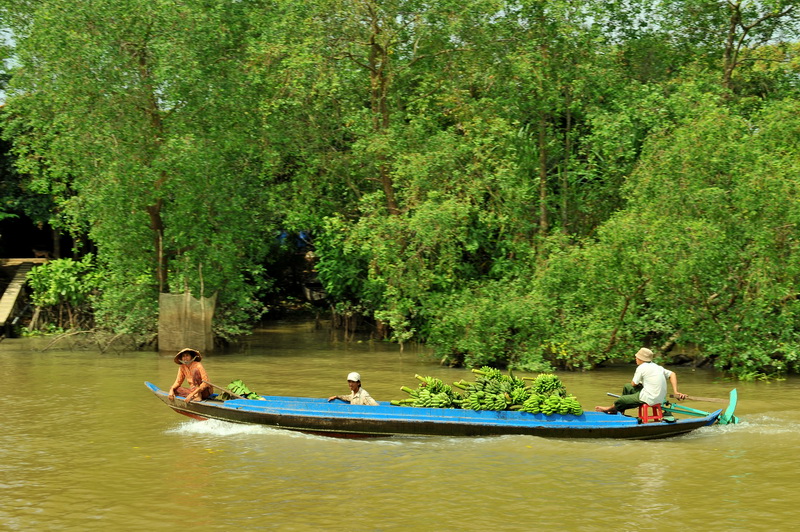
The best time to visit Vietnam Mekong Delta could be the flood season (from August to November) when the iconic specialties of the land are ready to serve. Some ingredients like the common sesban (Bong Dien Dien) are abundant during flood time. Nonetheless, if you prefer the dry conditions, getting there in the dry months sounds more reasonable. In fact, the peak season of tourism in the Mekong Delta is from October to February when the weather becomes mostly pleasant for everybody. This period features a clear sky, calm rivers, nice beaches, blooming flowers, and lush vegetables. Also, it’s rarely raining during these dry months, so the region seems to be most crowded during this time and the most expensive as the accommodation is well booked in advance. On the other hand, the low season of tourism lasts from March to July when a few tourists come to the delta, making it an off-season. Yet, this period offers the advantage of more reasonable prices and fewer crowds, resulting in a more authentic experience in the countryside.
Another milestone is to tour Mekong Delta in Vietnam during festivals by checking the calendar prior to the trip. The most critical festival in Vietnam and the delta region is the Lunar New Year Festival (Tet), which might occur around February, but this varies due to the lunar calendar. On this occasion, the region is colorfully decorated with lights and flowers, while each local house has a party-like atmosphere. What’s more, here are several most popular Mekong Delta festivals for your information:
- Ba Chua Xu Festival (from 23rd to 27th of April of the lunar calendar)
- Ok-Om-Bok Festival (Moon Offering Festival) (on the 15th of October of the lunar calendar)
- Binh Thuy Temple Festival (on the 14th and 15th of December of the lunar calendar)
- Whale Festival (on the 9th and 10th of January of the lunar calendar)
- Coconut Offering Festival (on the 15th of February of the lunar calendar)
- Cow Racing Festival (from 19th August to 1st September of the lunar calendar)
Traveling to Vietnam Mekong Delta, tourists enjoy a wonderful escape away from the city stress. Instead, they’ll be pleased with the idyllic and peaceful countryside landscape. The rural road might urge your bike trips. Along with the green sightseeing and pleasant photography of the southern houses, rice fields, canals, orchards, etc., get your opportunities to learn about the local living activities, eat the fresh fruits and folksy food, and relish the exceptional peace. There, you find no heavy traffic jams, noisy car beeps, or lines of busy workers. The local people enjoy their lives in a peaceful manner. Along with that, a boat trip on a bamboo sampan across the river and through canals to reach the floating houses and markets is a must-do.
The Most Famous Attractions in Mekong River Delta of Vietnam
Cai Be Floating Market
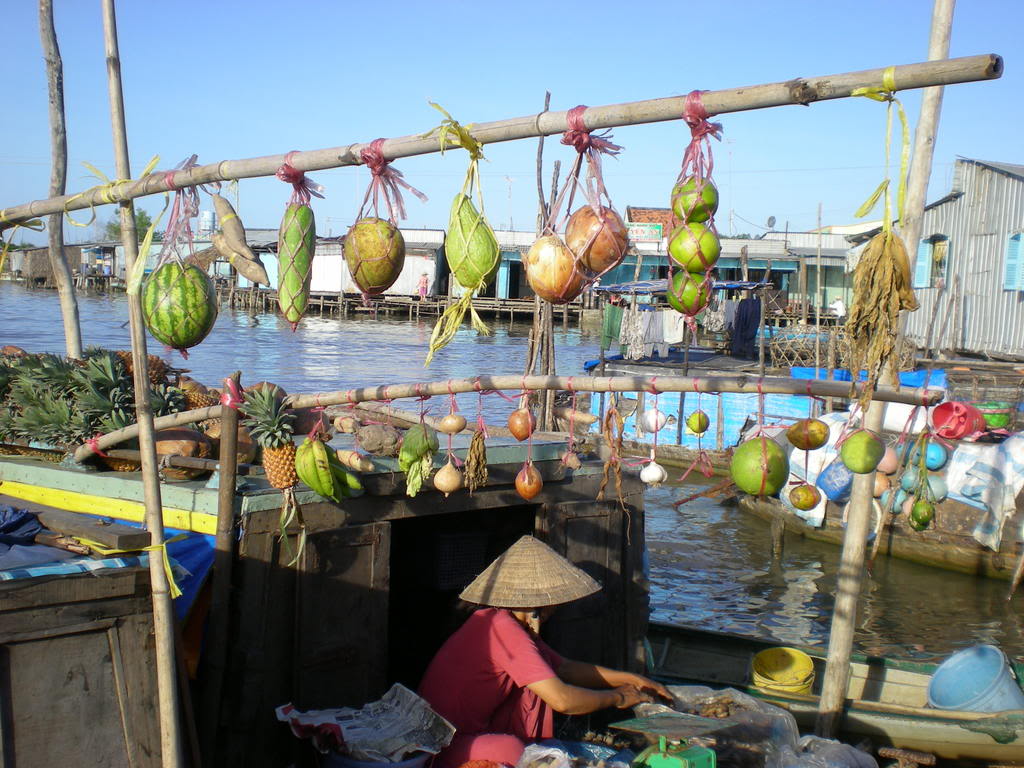
A trip on a sampan ride will take you to the interesting Cai Be Floating Market in Tien Giang Province. The market features hundreds of boats packed with local household items, fruits, flowers, and food. The waterway scenery is exciting and dynamic that merchants are selling items on the wooden boats. Looking around, you will be pleased to observe the floating houses, verdant tree ranges, orchards, and smiling kids, which ignite the friendly tones. People from Saigon enjoy a bike tour to Cai Be Tien Giang of Mekong Delta, and the 110km-cycling trips offer the next level of sports tourism model that participants can ride, laugh, take pictures, eat Mekong Delta food, and receive nice support on their weekend escape. Upon arrival at Cai Be town, it’s highly recommended to take a boat trip toward the local floating market in which you observe the spectacular waterway scenery, and meet the busy merchants who are selling products on the wooden boats. The river-land mixed town preserves the scenic countryside landscapes to please those coming from the cities. It offers a distinctive atmosphere of many mysterious canals, local activities on the floating markets, fruitful orchards, and Cai Be food. You should even try eating in the floating eateries that serve the boneless snakehead fish filled with minced pork and served with rice paper, fried spadefish, stewed chicken, gruel with duck and spinach, gruel with snakehead fish and bitter vegetable, fish stew with water lily, fish soup, southern pancake, and snakehead skewered by the bamboo stick and grilled in straw.
Phu Quoc Island
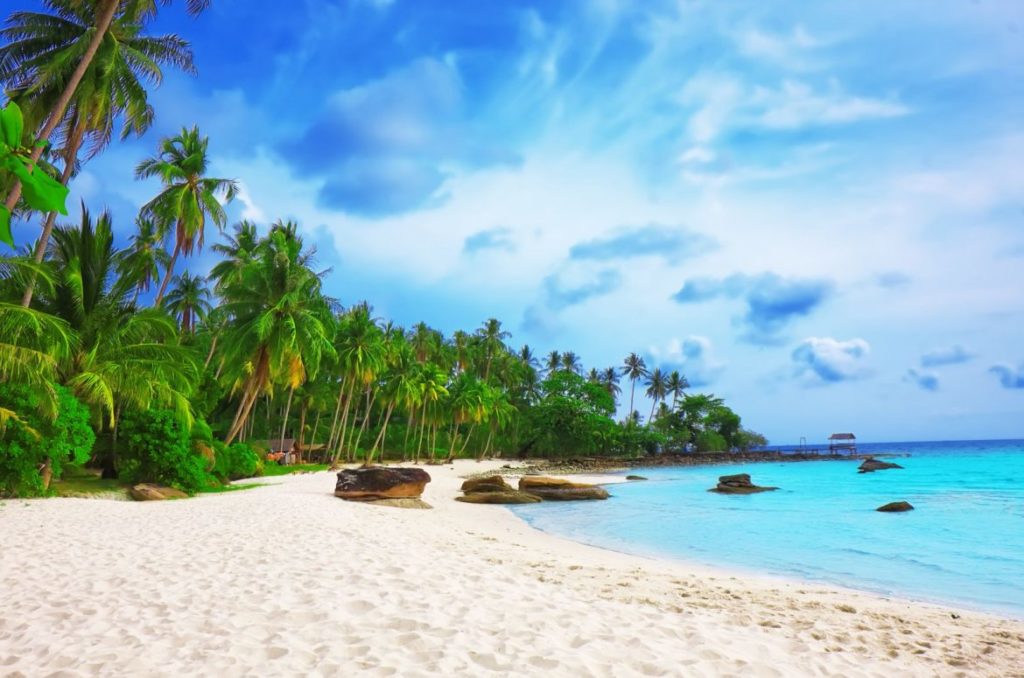
Kien Giang Province is best famed for the precious Phu Quoc Island – the largest island in Vietnam. In an area of 574 square kilometers, Phu Quoc has been attracting beach lovers and vacationers, who cannot help falling in love with the “pearl island.” The place has a fast-growing tourism sector, so its infrastructure has been improved much, with luxurious beachside resorts, entertainment parks, zoos, and shopping malls to better serve tourists. Besides the modern upscale corners, parts of the islands remain intact and beautiful for nature lovers to relish. In Bai Sao beach, besides an awesome beach view, you’re likely to meet the fishing boats, basket boats, and friendly residents. Before your flight lands, get a chance to observe the Phu Quoc coastline from the top view, which is spectacular. Phu Quoc nowadays wins reputation and compliments on the gorgeous beaches with the white sand and transparent water beside the splendid resorts (with attractive combos), and newly constructed entertainment sites. People find it super-easy to have a beach vacation in Phu Quoc as the local resorts often run appealing promotion programs. Families, couples, groups of friends, and company trips have been spending their time off on the lovely island, and many of them even re-visit it more than once a year. The fish sauce manufacturing sector of the region produces souvenir fish sauce bottles bought by tourists. Along with the luxurious corners, the place preserves the historical Dong Duong market, traditional bridges, Nguyen Trung Truc’s temples, etc., for guests to feel and explore the traditional and historical values of the site.
If you’re asking for things to see and do on Phu Quoc Island, here are the top names:
- Vinpearl Safari Phu Quoc Wildlife Park has an open zoo and a semi-wild area (Safari Park)
- VinWonders Phu Quoc is an amusement park highlighted with Aquarium, Water Park, and outdoor and indoor playing areas.
- Dong Duong Market features market stalls, restaurants, bars, and street vendors
- Hon Thom Island is where you watch corals and admire the aquaculture and pearl farming industry
- Long Beach (Bai Dai) was voted by BBC as one of the 10 most stunning and pristine beaches in the world
- Star Beach (Bai Sao) is a charming beach site ranked highly by tourists during the peak time
- Tranh Stream is a stunning waterfall with animal sculptures carved on the botanical grounds
- Rach Vem fishing village is a small little site in which you learn about the local lifestyle and enjoy the peace. The wooden bridge leading to the village is very photogenic.
Sam Mountain
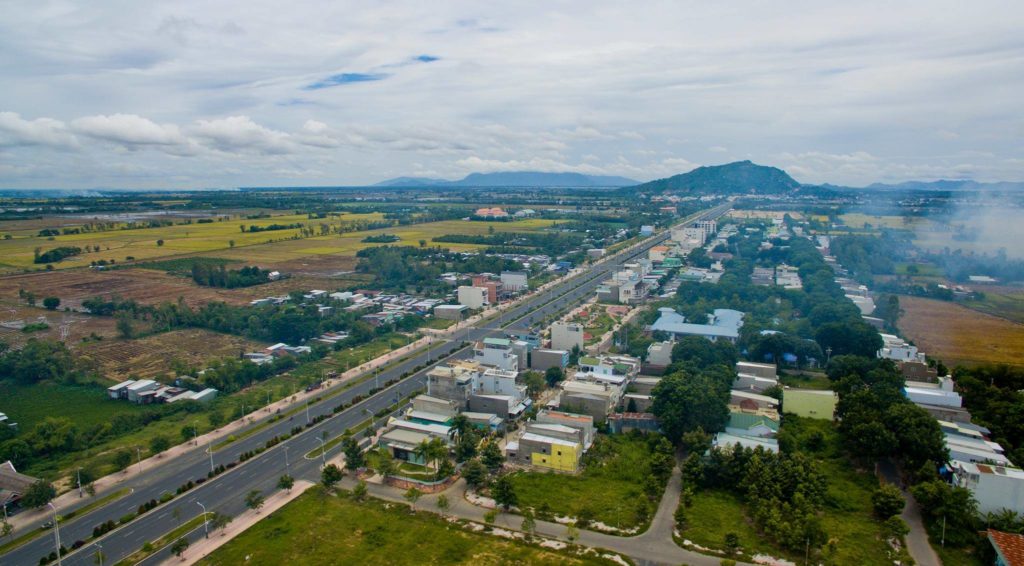
An Giang Province is honored by the sacred Sam Mountain, which attracts thousands of pilgrims across the country. It serves as a pilgrimage place for the Vietnamese. Especially, the mountain becomes packed with visitors during the beginning days of the New Year, when people come to pray for a healthy and prosperous life. Getting immersed in the sacred countryside vibe, you might feel peaceful in mind and befriend Nature. The mountainous landscape and the age-old pagoda are meaningful retreats for any tired soul. Pilgrims have a strong belief in the 230m-high Sam Mountain and the annual Ba Chua Xu Festival plays an irreplaceable role in their lives. Know that Sam Mountain is the highest mountain in the Mekong River Delta Vietnam, and it features a green and grandeur spectacle. The historical remains in the areas, namely the Ba Chua Xu Temple, Thoai Ngoc Hau Tomb, Tay An Pagoda, Bach Van Hill, and Tao Ngo Garden, are all cherished by the residents. Each place of interest is worth a visit, and among these, Ba Chua Xu Temple (Holy Mother of Realm) is the most famous site. The temple features a solemn and ancient architecture constructed in 1820. There exist secrets and legends around the temple and its magic. On an annual basis, worshippers from all over the world come to this temple to ask for the blessing, luck, and protection. Especially, from 23rd to the 27th of April of the lunar calendar, the Ba Chua Xu Festival attracts numerous participants, which marks the peak season of tourism and the busiest period of Chau Doc – An Giang.
Tram Chim National Park
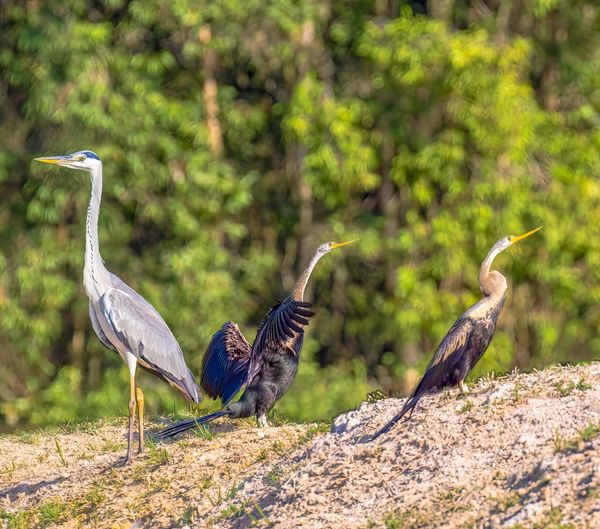
This is a valuable green protected area in Dong Thap Province. It’s also called Dong Thap Muoi or Tram Chim Tam Nong, which has been famous for the “sarus cranes or “Grus antigone” (the red-crowned cranes, as popularly called by the locals). This kind of crane gathering on the rice fields included in the protected park creates a fairy spectacle. These cranes are included in the IUCN Red List of Threatened Species, confirming that Tram Chim National Park is a great place to preserve and visit. The park has an area of 7,588 hectares, and its terrace belongs to the reed fields of the ecological agricultural region of the Mekong Delta. It remains diverse in vegetation types, like the seasonally inundated grasslands, cajuput forest, lagoons, and lotus ponds. The area also recorded a large flock of big waterbirds migrating during the winter months.
The “sarus cranes” gather in this park for food during the dry season (December – May) when the place becomes migrated by 60% of these red-crowned cranes – the tallest birds in the world with the red head, tall feet, and silky long broad wings. It’s amazing to sightseeing and photographing the groups of red-crowned cranes gathering on the rice fields. The view turns best in the red-light condition during sunset when the cranes seem to perform dancing. Furthermore, between September and October is the birds’ breeding season, when it’s possible to find the nest of birds hanging on the tree branches, the little birds flying, and the mother birds feeding the hatches. Traveling to Tram Chim Tam Nong, visitors can enjoy sightseeing the rice fields, canals, cajuput forest, lotus pond, etc. The best activities are a motorboat trip to access the cajuput forest, watching birds, and eating the local food.
Can Tho City
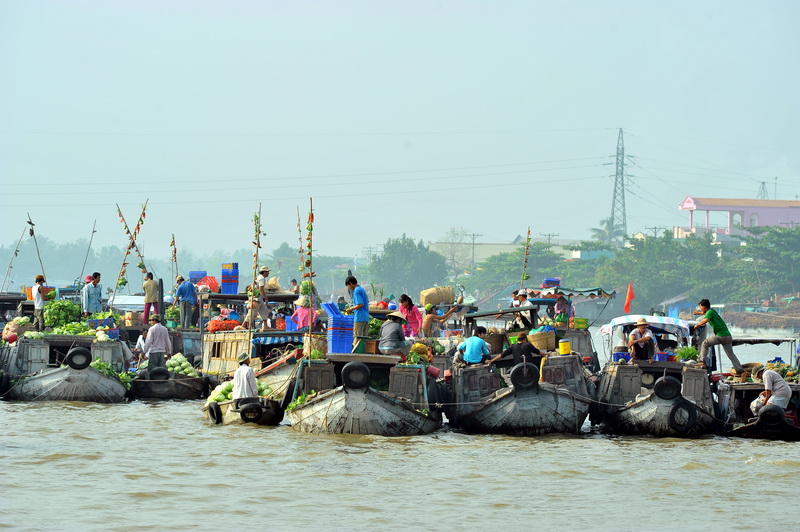
Can Tho City can be considered the capital of Mekong Delta in Vietnam, which is attractive and full of great sites to see. While most forums point to Cai Rang floating market, know that this city has more to offer. As a popular tourist hangout venue, Ninh Kieu Wharf is often packed with tourists who get there to enjoy the sunset and then the city view at night when the whole region is illuminated by the electric lights. Ninh Kieu Wharf is the first and the must-check in when you’re in Can Tho. Strolling around the wharf will leave you with dozens of beautiful pictures. You can also find joy in the street market, local food, drink at a pub, etc. And yes, the Indochina Tour to Can Tho cannot be complete without Cai Rang Floating Market in which you find many small and large boats selling all sorts of items (tropical fruits, vegetables, local food, etc.). Try leaning over your boat and ask for what you want to buy/eat. Don’t miss a chance to try tropical fruits like juicy rambutans, mangoes, guavas, and more. Look at the bamboo pole at the front of the boat displaying samples of things sold. Then, you can identify what each vessel is selling. What’s more, homestay in Can Tho has grown to be an attractive service for intimate experiences. The host will serve you as if you’re a part of their family; you can cook with them, have family meals, and participate in their farming activities. If you would like a tour of the countryside, they’re happy to assist.
Lung Ngoc Hoang Nature Reserve
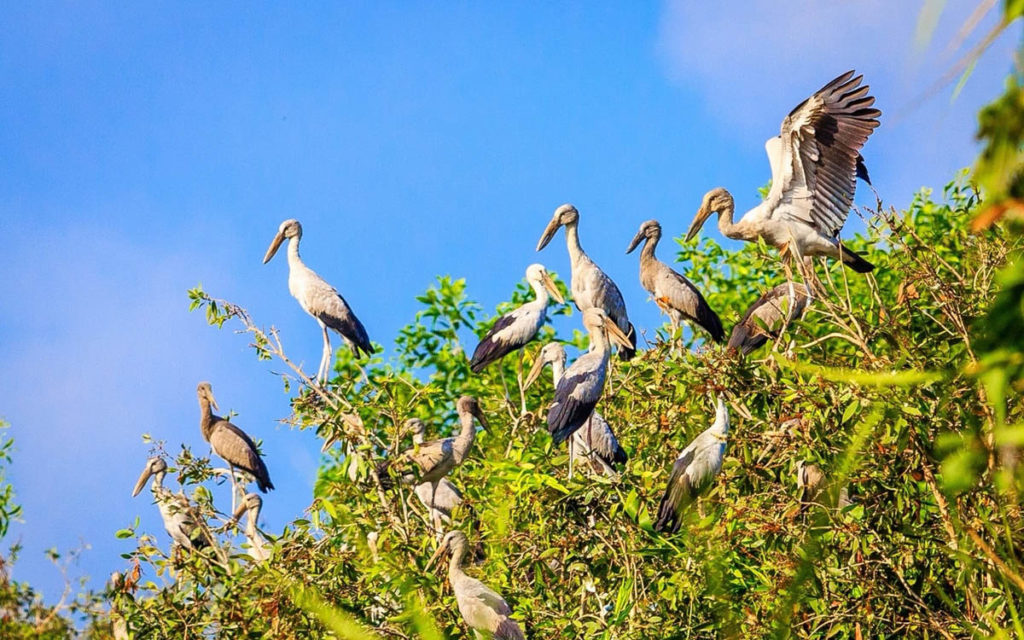
Also named Lam Truong Phuong Ninh, Lung Ngoc Hoang Nature Reserve is situated in Hau Giang province. This is an ecotourism site with green grassland, swamp, and cajeput forest. The place is rich in water bird species, marine species, and grass landscape that attract explorers. If your interests are in green escape and lush nature, this nature reserve site owns the forest and canals to fulfill your wildlife expeditions. In an area of 6,000 hectares, the site features a vast environment for being close to nature and exploring the new wildlife every step you trek. The dominant cajeput forest has verdant scenery to feast the eyes and photograph. The site also hosts bird communities and aquatic plants in the canals. Ecotourism activities in Lung Ngoc Hoang include boat trips on the canals and around cajuput scenery, sightseeing from a watching tower toward the panoramic nature preserve, and watching birds. What’s more, this tourist site hosts the “Don Ca Tai Tu” program served by the southern artists who sing and play musical instruments – the “spiritual food” of the Vietnam Mekong Delta. The nature-friendly experience and fresh air in this eco-site will please trekkers, backpackers, and explorers.
Bac Lieu Bird Sanctuary Nature Reserve
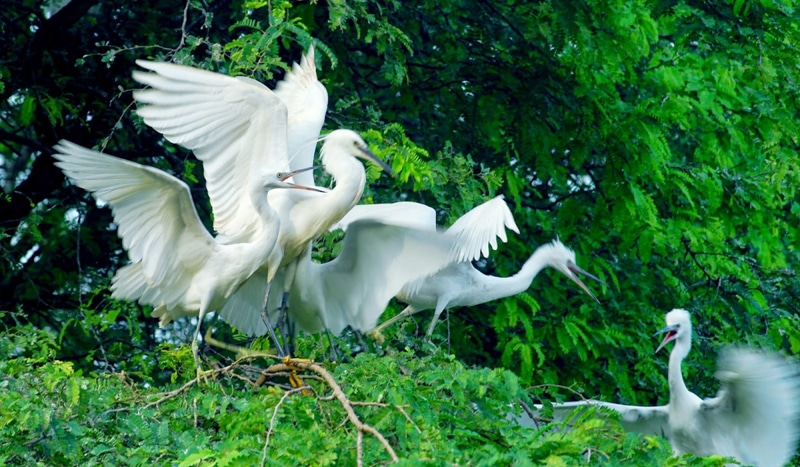
Known as an important bird sanctuary, Bac Lieu Bird Sanctuary Nature Reserve hosts a variety of bird species. The site is wild, scenic, and pristine that birds call it home. In the protected status, this site provides ideal settings for befriending Nature, refreshing, and appreciating how charming Nature is. In an area of 127 hectares, this green site has a terrace of mangrove forests and rice fields. It is the largest bird sanctuary in Vietnam Mekong Delta, in which the water birds are safe to make their nests in groups. So, if you have an interest in birds’ life, their habits, their nests, etc., it’s a meaningful trip to visit this critical bird sanctuary. The activity of bird watching in the protected area is truly safe and enjoyable. Also, the green, idyllic, and picturesque spectacle enables visitors to forget their city concerns, so all left is just the joy to watch the beautiful birds. A walk around the site might let you come across the birds’ eggs on the ground. You can also expect to see the large birds with 2m wings and 10kg weight as they’re living in this Nature Reserve. This site is a pride of Bac Lieu tourism, and the itinerary to this southern province should always include Bac Lieu Bird Sanctuary Nature Reserve. This is the precious greenery left in Mekong Delta and Vietnam regardless of the modernized sectors.
Tra Su Cajuput Forest
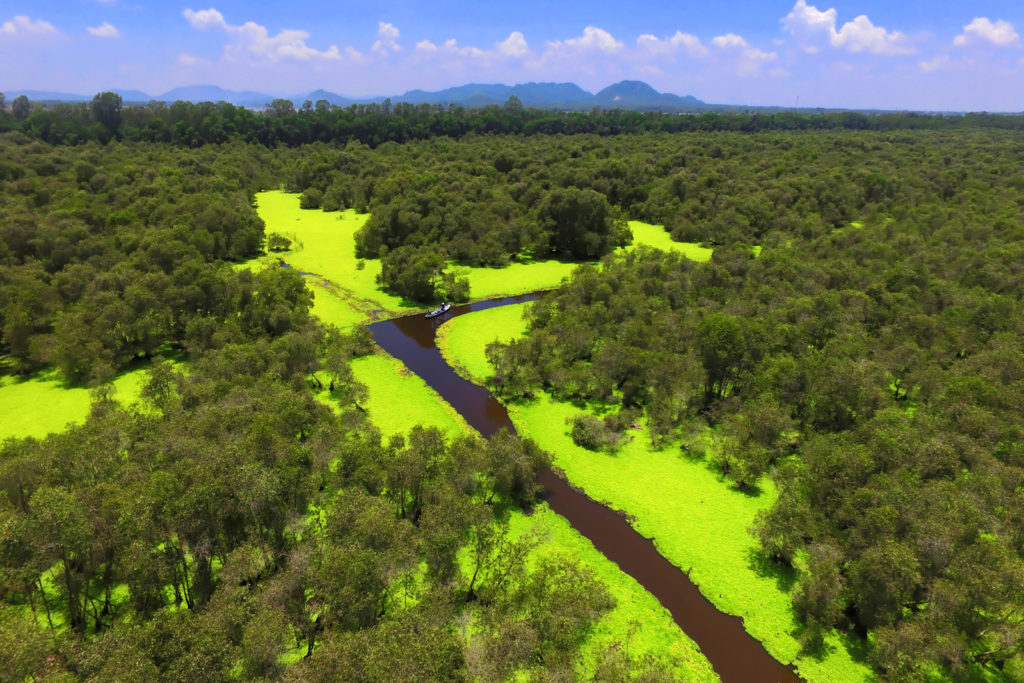
Among the best Mekong Delta attractions, Tra Su Cajuput Forest in An Giang Province is often visited by young travelers who enjoy taking pictures of the wild environment during a boat trip. Here, you find the protected ecosystem of cajuput trees, a variety of birds, and other wildlife. In the flood season (from September to November), this attraction turns out to be most beautiful thanks to the giant green carpet of duckweed. It’s also the best time to visit Tra Su Cajuput Forest when photography goes best, and the boat trip is a must-do. You can expect to capture the magical moments when the sunlight is reflected on the water surface. To enjoy the most vibrant sight, you’re recommended to arrive around 07:00 – 09:00 AM when the atmosphere is pleasant and the birds are flying and singing. There is also an observation tower from which you can closely and clearly watch the birds’ life through binoculars. This area is home to over 70 species of birds and storks beside the rich system of fauna and flora. The off-the-beaten-track hike in this address sounds inspiring too. Recently, this area has introduced Vietnam’s longest bamboo bridge of 10km which looks magnificent. For a boat trip, you’re advised to wear light clothes, hats, and sandals to stay comfortable. Besides, bring a fully-charged camera to capture the beautiful moments. A binocular is great equipment if you bring one. You can also ask the boat rower where the birds are gathering the most.
Some typical Vietnam tours take you to the Mekong Delta
Vietnam tour package 12 days
Vietnam tour package 15 days
Best Accommodations in Mekong Delta Vietnam
Know that the Mekong Delta region has twelve provinces and one province-level municipality, of which each destination is highlighted with the best hotels and resorts. Due to the places to which you go, it would be impossible to list out all the good accommodations in each province. Therefore, the following list includes the top picks highly booked by a majority of tourists, just for your information.
Victoria Nui Sam Lodge
If budget allows, let’s book a room in Victoria Nui Sam Lodge upon your trips to Sam Mountain in An Giang Province. The luxurious lodge is set on the side of the Sam Mountain, featuring the upscale infinity pool for an unlimited view of the vast fields and the entire region beneath. Designed in a bungalow style, each room has brick walls and tiled roofs for a cozy and high-quality stay. The Lodge helps you feel and be close to the natural surrounding while covering the sense of wellness. The luxurious lodge is fully equipped for your comfort, and it also provides different services of local tours and transportation that you can take advantage of. A reference price for a one-night stay is VND 1,200,000. Think about it!
Azerai Can Tho
Located in the Cai Rang District of Can Tho Province, Azerai Can Tho Resort consists of 60 rooms and 5 villas, which are merely accessed by boats. Does this sound interesting? The place is bordered by giant banyan trees that result in your absolute privacy. The rooms in Azerai are designed in a nature-friendly and modern style, which boosts the tranquility. Each room has an open view overlooking the peaceful lake, river, and garden. This masterpiece will please the high-end guests who demand privacy and a bustle-free atmosphere during their precious time off. Being luxurious and private, Azerai Can Tho features expensive prices too. For your reference, it costs around VND 5,000,000 for a one-night stay.
The Island Lodge Thoi Son
This is a private resort complex located on Thoi Son Island, in the center of the Tien River, in Chau Thanh District, Tien Giang Province. The place has 12 rooms in total and is encompassed by an awesome panoramic view. Its dominant color is the pure white applied to the curtains and mattresses combined with the cheerful patterns to please your eyes. Inside the rooms are bamboo tables for a nature-friendly feeling. The Island Lodge is a precious accommodation property you need to stay away from the city stress. Rather, here you find the absolute privacy, freedom, and peace to recharge. Pay around VND 4,900,000 for a one-night stay in this ritzy resort.
Ben Tre Riverside Resort
The coconut land “Ben Tre” is proud of this newly built and first 4-star resort. It has a total of 80 rooms and a giant infinity swimming pool. The place ensures your comfort and pleasure during your Mekong Delta tours and your stopover in this city. Ben Tre Riverside Resort also offers a shuttle bus service from the site to the Ben Tre Night Market so that you can access the local attractions and enjoy the local food at ease. The room is well-equipped, and no need to worry about the lack of facilities. Besides, it’s decorated in a green color theme, and the furniture is made from coconut wood. This resort often runs the promotions; sometimes, it costs around VND 1,290,000 for a one-night stay, three meals, and a tour of the sunflower fields.
Fusion Resort Phu Quoc
Among the most-booked luxury hotels and resorts on “Pearl Island,” let’s draw your attention to Fusion Resort Phu Quoc. It offers a cozy and splendid accommodation where you can enjoy the nicely-designed rooms, onsite restaurant, outdoor swimming pool, and 24-hour front desk support. Especially, what sets this resort apart is the awesome spa center with massage services and sauna room. Along with that the fitness center and children’s playground are the highlights. Make sure to let yourself be pampered by the upscale spa services. The site is merely a 10-minute drive toward Vinpearl Safari Phu Quoc, so enjoy your trip. You will need to spend around VND 4,000,000 to book a night in this high-end spot.
JW Marriott Phu Quoc Emerald Bay Resort & Spa
Around 16km from Phu Quoc International Airport, the famous JW Marriott Phu Quoc Emerald Bay Resort & Spa has long been appreciated by beach vacationers. Without a doubt, this is one of the best accommodation sites on “Pearl Island.” The super-duper luxurious resort owns three restaurants, contemporary bars, talented chefs, indulgent spa services, a private beachfront, and many more advantages that secure your happy stay. Make sure to relax by the spa offers, enjoy an array of fresh seafood, and drink a wide selection of wines and beverages. It’s your vacation and you’re staying in one of the finest resorts ever built. The experience is expensive yet praiseworthy, so prepare your budget for a night of around VND 5,000,000. The actual stay will help you conclude if it’s worthy.
Muong Thanh Luxury Ca Mau Hotel
This is the branded hotel that you should always choose to stay in if you’re in Ca Mau Province. The Muong Thanh Luxury Ca Mau Hotel has the giant look attracting almost all visitors, and indeed, its hospitality service is guaranteed by the famous brand “Muong Thanh.” You can expect to be gently served by the spa center, hot tube, cocktails by the bar, and tennis court. The property even provides pickup services from the Ca Mau Airport. This seems to be the best place to sleep in Ca Mau, so no need to check elsewhere. Search for initial pictures of the hotel and its facilities, and then perform an actual booking before your arrival. The place is also appreciated for serving great Vietnamese breakfast. Expect to pay around VND 1,300,000 for a night there.
Top Foods to Eat in Mekong Delta Vietnam
The Mekong Delta will serve you yummy treats! To taste the best, you’re recommended to arrive in the flood season (between August and November), when the fish is abundant, fresh, and delicious. The names of food to eat in the Vietnam Mekong Delta can extend to pages, yet the top picks are sorted out as follows. The local food features sweet and succulent tastes, which are hard to forget.
Fish soup with Siamese mud carp and common sesban (Lau Ca Linh Bong Dien Dien)
This is an amazing soup/hotpot of the southern land, especially during the flood stage. Siamese mud carp (its scientific name is Henicorhynchus siamensis) and common sesban (or Egyptan rarrlepod) are the special ingredients well combined to make up an appetizing fish hotpot. In the flood months, the fish becomes most delicious, almost without fishbone while the taste is sweet. Along with that, this is the blossoming season of the wild common sesban, when it’s yellow sand savory. The fish soup is extraordinary thanks to a variety of tastes mixed, like the sweet fish, scrumptious and aromantic common sesban, spiced fish sauce and chili, etc. The food is unique and can only be found in the Mekong Delta region. Explore the taste!
Field mice grilled in a terracotta jar (Chuot Dong Nuong Lu)
While somebody is afraid of the grilled mice food, the Mekong Delta residents consider it a yummy feast. Per the locals’ concepts, the field mice merely eat the ripe rice on the fields, so they have the greasy and nutrient meat, which is best for being grilled in the terracotta jar. Once the field mice are made clean and spiced with some seasonings, they will be put in a jar for grilling in around 1 hour. The process requires experience to grill the mice rightly. After 1 hour, the spiced mice will turn yellow, aromatic, and soft with crispy skin. The food is best served with fresh vegetables and herbs. The local men do love this food, and they often enjoy the grilled pieces with the rice wine. This is also a food choice to welcome the expatriates. The taste of the food is much better than its look. The best place to have the grilled field mice is Dong Thap Province.
Fish stewed with water lily (Bong Sung Mam Kho)
Water lily is a great cooking ingredient, discovered by the southern people. Not only does the water lily look beautiful but it is also delicious. During the flood season, this kind of “flower” flows a lot on the local canals and shows off its beauty. Generations of the Mekong River Delta people master the way to peal out the cover of the water lily and cut it into small pieces. These pieces will be put into the stewed fish, and the fish sauce used is made from Siamese mud card (Ca Linh in Vietnamese). The fish sauce needs to be hard-boiled, filtered, and removed from the fishbone. Also added to the boiling fish sauce are the citronella, shrimp, mussel, chili, and the must-have water lily. The mixture is very aromatic and yummy, covering a variety of tastes, from the sweet fish and shrimp to the spicy chili, mint citronella, and crunchy water lily. The food is best served with the plain rice.
Snakehead skewed in a bamboo stick and grilled in straw (Ca Loc Nuong Trui)
Not only does the snakehead serve great in soups, but it’s also a perfect ingredient for grilling in a folksy style of the countryside. The fish must be processed to have a clean intestine, then it is skewered in a bamboo stick. That stick of fish will be made fixed in the soil and covered by straw for the grilling step. The complex of the cooking is knowing when to take the fish out of the straw. It’s mostly based on the cook’s experiences. They won’t let the fish overcooked or not-fully-cooked. The skill also lies in the amount of straw used. Too much straw might cause the fish to be burned and bitter whereas too little straw might be not enough to fully cook the fish, which makes it fishy and raw. The most expected version is the medium (neither well-done nor rare). Once served, the grilled snakehead should be eaten with rice paper, fresh vegetables, starfruit, cucumber, banana, and fish sauce. Its smell, look, and taste might make you mouth-watering. The taste won’t fail to wow you.
Vietnamese southern pancake (Banh Xeo Mien Tay)
Being different from the pancake version of central highlands, the southern pancake has larger sizes and more fillings. Especially, it has the common sesban – the additional luscious ingredient. The typical pancake of the Mekong Delta in Vietnam is made from the finest rice flour mixed with coconut milk and turmeric powder. Meanwhile, its fillings are delectable with pork slices, shrimp, green bean paste, bean sprouts, spring onions, etc., and the unique common sesame. The success of the food also lies in the sweet-and-sour fish sauce, which is well-spiced to enhance the taste. While the cover of the pancake is crunchy, the filling is succulent and flavorful. The pancake is often served with raw vegetables and herbs. There are several ways to eat “Banh Xeo Mien Tay;” you can make rolls of it or mix every component on a plate and soak them in the fish sauce. Whatever way, this is one of the best dishes you must eat in Vietnam Mekong Delta.
Fish salad with Neem tree leaves (Goi Sau Dau Ca Sac)
This food originated from Cambodia and becomes a specialty of the bordering provinces namely An Giang and Kien Giang. Many families in the Mekong Delta Vietnam enjoy this kind of fish salad, which features a variety of tastes. First of all, the salad needs the flowers and young leaves of the Neem tree (Sau Dau in Vietnamese), which have a bitter taste and remedial effects. Added to the salad are the small pieces of the dried snakeskin gourami fish (Ca Sac in Vietnamese), slices of boiled bacon, chili, and cucumber. The components will be mixed and soaked in the sweet-and-sour mandarin fish sauce to establish the flavorful fish, which is sour, bitter, spicy, and sweet. Many foodies find it’s hard to resist this fish salad, and somebody even misses the taste upon home return. Enjoy the salad with the local rice, and you can eat like the locals. The onsite culinary experience becomes real and memorable.
The salted fiddler crab (Ba Khia Muoi)
The fiddler crab (Ba Khia in Vietnamese) is a special species in Bac Lieu Province. The locals find a way to salt the crabs and make the delicious treat. The processed crabmeat will be mixed with chili, garlic, sugar, lemon, and vinegar for around 30 minutes. Once the mixture is soaked enough, it becomes succulently spiced and is best served with plain rice. The rich flavors of the nutrient crabmeat, sour lemon, sweet sugar, and spicy chili when combined with the plain rice can enhance your palate, which urges you to enjoy the meal more. This way, your belly is nicely and fully treated. Hence, upon your stay in Bac Lieu Province, make sure to discover this food and enjoy it on the spot.
Vietnam Mekong Delta Future Orientation
There have been seminars to discuss the orientation of tourism development in the Mekong Delta. The local tourism products are associated with boat trips, orchards, and folksy food. Nonetheless, the local brand is lacking attraction and breakthroughs so not many foreigners know how interesting and beautiful the delta is, compared to the other regions. In that sense, the future orientation of the Vietnam Mekong Delta Tour is to link it to the Saigon Tour. For example, guests can opt for a bike tour from Saigon to Tien Giang. With a vision for 2030, the region will focus on sustainable tourism development to orient and attract both domestic and foreign tourists to the countryside sightseeing tours, boat trips, community tours, cultural and historical tours, and ecotourism. Besides, it has the potential to develop pilgrimage trips, island weekend escapes, and beach vacations. Mekong Delta also has places of interest for tourists, self-organized groups, students, and professionals (aged 33 – 50 years old) to explore and research. The spiritual tours to the well-known temples are worth investing too. In sum, this region has the typical ecological landscapes of rice fields, canals, rivers, islands, and the four-season orchards, along with the age-old history, culture, and tradition. With these identified characteristics, the Mekong River Delta tourism industry is oriented to develop ecotourism, orchard tours, and boat trips. It’s a valuable region that holds fantasy and secrets to explore.

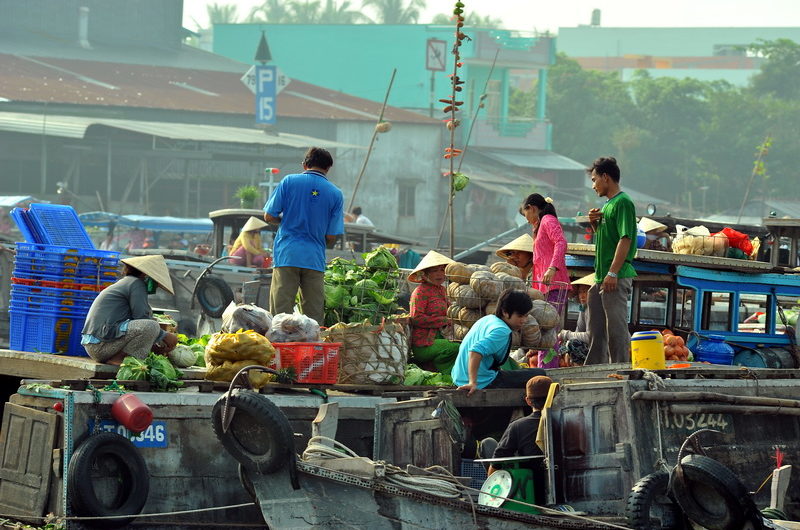
Comments